
Carcassonne, the world-famous French city, known for its imposing fortifications erected during the Antiquity and the Middle Ages. This fortress, surrounded by magnificent walls, still stands today as one of the most unique French cities.
In this game, players must develop the area around Carcassonne. They will place their followers onto roads and into cities, monasteries and fields. Only those who make the most judicious placements will gain the points required to win the game.
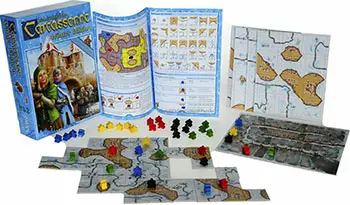
Components
- 84 Land tiles
- 40 followers in 5 colors
- 1 scoreboard:
- 1 player aid
- Instructions
Overview
On their turn, players place one tile. This is how roads, cities, monasteries and fields will be created, one tile at a time. To score points, players will need to place followers on these tiles.
Points are scored throughout the game and at the end of the game. After the final scoring, the player who scored the most points is the winner.
The rules for Carcassonne - Winter Edition are the same as those for the basic Carcassonne game. The 12 tiles featuring animals are played according to the normal rules.

Setup

The Start tile is placed face-up in the center of the table. Shuffle the other tiles and place them in various face-down stacks within reach of every player.
Place the scoreboard close to the edge of the table to give players enough room to play their tiles in the middle of the table.
Each player takes the 8 followers in his color and puts one (called marker thereafter) on space 0 of the scoreboard (the space located in the lower right-hand corner).
Each player then keeps their remaining 7 followers in front of themselves: this is their personal supply. Players choose how the first player is designated, or simply let the youngest player begin.
Game Play
Players take their turn one after the other, starting with the first player and then proceeding clockwise: on their turn, a player must do the following actions in the order listed below:
Draw and place one new Land tile.
Then, the player may take one (1) of his followers from his supply and put it on the tile he has just placed.
If by placing a Land tile one or more roads, cities, and/or monasteries are completed, these features are scored immediately.
The player's turn is now over and the next player takes her turn by following the same rules.
1. Placing Land Tiles
At the beginning of their turn, a player must draw one of the face-down Land tiles. She looks at it and shows it to the other players (allowing them to "help" her).
Then, she places that tile on the table according to the following rules:
The new tile (the one with a red border in the examples) must be placed in such a way that at least one of its sides touches one of the previously placed tiles. The new tile cannot only be connected by a corner.
New tiles must always continue fields, cities and/or roads.
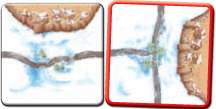
The new tile continues the road and field sections.
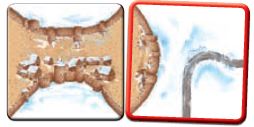
The new tile continues the city section.
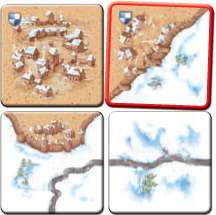
One side of the new tile continues the city and the other continues the field.

This placement is not allowed.
In the unlikely situation where a drawn tile cannot be placed (all players must agree), the player removes the tile from the game and draws another tile.
2. Placing New Followers
Once a player has placed her tile, she can put one of her followers on that tile according to these rules:
- A player may only place 1 follower per turn.
- The player must take the follower from her supply.
- The player may only put the follower on the tile she has just placed.
- The player must choose where she will place her follower. As such, the follower can become a...
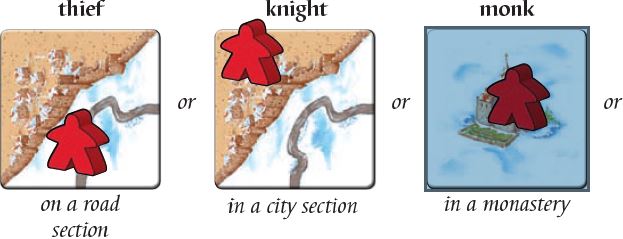
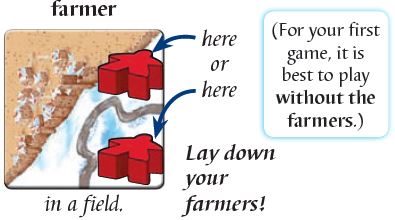
The player may not place her follower on a road, in a city or in a field if that section is connected to another tile where there already is a follower (no matter which player owns that follower). For example:
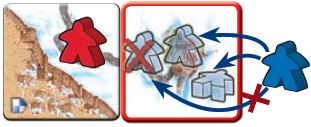
Blue may only place a farmer or a monk since there already is a thief on the continued road.

Blue cannot place his follower as a knight because the city is already occupied. He may, however, place a thief on the road or a farmer in the field.
If a player has placed all of her followers, she keeps placing one tile each turn. A player is never allowed to retake one of her followers from a tile. However, a follower is returned to its supply when the road, city or monastery it occupies is scored.
Then, the player's turn is over. After, in clockwise order, the next player takes his turn, followed by the next one, etc. IMPORTANT: If, after placing a tile, one or more roads, cities and/or monasteries are completed, they are immediately scored before the next player's turn.
3. Scoring
Completed Road

A road is complete once both ends of the road are connected to a crossroad, a city section, a monastery or the road loops onto itself. There can be any number of road sections between both ends.
A player who owns a thief on a completed road scores 1 point per tile used in the completed road (make sure that you only count the number of tiles, since a single tile can be used for more than one road section).
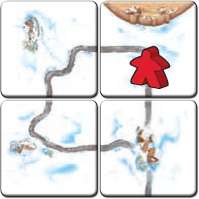
Red scores 4 points.
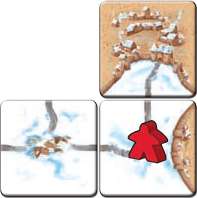
Red scores 3 points.
Scoreboard
When you score points, move your marker a number of spaces on the scoreboard equal to the number of points scored.
If you move beyond space 50 of the scoring track, put your marker on its side to indicate that you now have more than 50 points and keep moving your marker as usual on the scoring track.
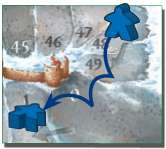
Blue scores 3 points. He moves his marker from space 48 to space 1.
He then lays his marker on its side to show that he passed space 50.
Completed Clty
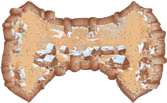
A city is complete when it is surrounded by walls and there are no gaps in the walls or the city. There can be any number of sections in a city.
A player who owns a knight in a completed city scores 2 points per tile in the city (count the tiles and not the sections). Each banner in the scored city also gives the player 2 points.
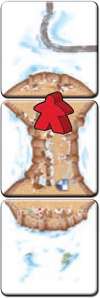
Red scores 8 points (3-tile city and 1 banner).
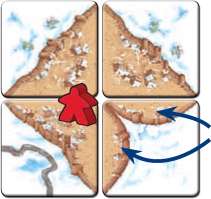
Red scores 8 points (4-tile city and no banners).
When 2 city sections are on the same tile, it is worth only 2 points since it counts as 1 tile.
What if there are more than one follower on a completed road or city?
With some clever tile placements, it is possible to connect road and city sections, resulting in a road with more than one thief or a city with more than one knight.
The player with the most thieves or knights scores the totality of the points.
In case of a tie, the tied players each score the points.
Completed Monastery

A monastery is complete when it is surrounded by tiles. The player who owns a monk in a completed monastery scores 9 points. (1 point per tile, including the tile with the monastery).
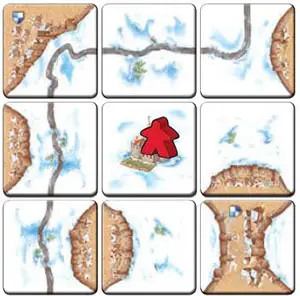
Red scores 9 points. (the monastery tile itself and the 8 surrounding tiles).
Followers go back into their player's supply

After scoring a road, a city or a monastery - and only then - the followers used in the scoring are returned to their player's supply.
These returned followers may become thieves, knights, monks and farmers during the following turns.
It is possible for a player to place a follower, score a road, a city or a monastery and see this same follower return into their supply on the same turn. The order must always be as follows:
- Complete a road, a city or a monastery with the new tile. 3 points.
- Place a thief, knight or monk.
- Score the completed road, city or monastery.
- Return the thief, knight or monk to its supply.
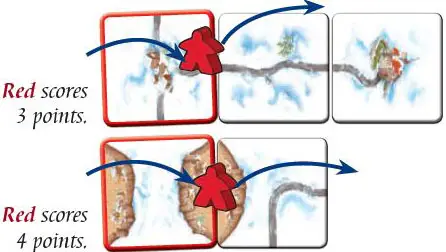
The Fieds
Reminder: For your first game, we recommend playing without farmers and fields).
Connected field sections create a larger field. Fields are not scored during the game. Players are allowed to place farmers into a field section, but those are only scored at the end of the game.
A farmer remains in the field where it was placed until the end of the game and is never returned to its player's supply!
(To show this, lay the farmer on the tile instead of placing it standing up).
Fields are separated from one another by roads, cities, and the edge of the board. (This is particularly important during the final scoring!)
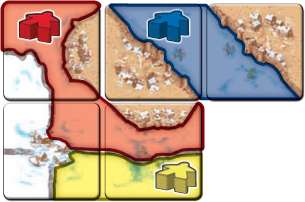
All three farmers have their own fields.
The road sections and the city divide the field into three distinct fields.
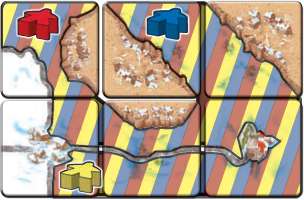
By placing this new tile, the three fields become one single field where each player has one follower.
Note: The player who placed this new tile cannot put a new farmer in the field since there already is at least one farmer (three in this case) in the connected fields.
End of the Game
When a player places the last tile, the game ends after his turn. Then, players proceed with the final scoring.
Scoring Incomplete Cities, Roads, and Monasteries
During the final scoring, incomplete roads, cities, and monasteries are scored. A player who has a follower on an incomplete road, city or monastery scores 1 point per tile. For cities, each banner is also worth only 1 point. In case of a tie, use the same rules as for completed features.
Once a feature is scored, return the follower to its supply. This should prevent any potential mistakes during the final scoring.
Scoring Farmers
(For your first game, if playing without farmers and fields, you will not need to score them).
When scoring the farmers, only completed cities are counted.
The farmer must be in a field that touches one or more completed cities. The distance between the farmer and the city does not matter.
For each completed city that the field touches, the player with the most farmers in that field scores 3 points. The size of the city does not matter. If some players are tied for the most farmers, they each score the points for that field.
A field is only worth points if it touches at least one completed city. More than one field may touch and score the same completed city. Each field is scored by following the rules above.
Once all fields have been scored, the final scoring and the game are over.
The player with the most points is the winner. In case of a tie, play another game to determine the winner!
The Gingerbread Man Mini-expansion

A cold winter has wrapped the walls of Carcassonne. The citizens waste very little time before preparing hot beverages and sweet pastries.
Life around Carcassonne slows down. Occasionally, the people catch a glimpse of a new character, but a glimpse is all they've ever been able to catch.
Components

- 1 wooden gingerbread man
- 6 tiles featuring the gingerbread man

Setup

The basic rules for CARCASSONNE remain unchanged. This mini-expansion can be played with Carcassonne - Winter Edition since their tiles share the same back.
The six new tiles (those with the gingerbread man icon) are shuffled with the other tiles from the Winter Edition. Before starting the game, the wooden gingerbread man is placed on the city section of the Start tile.
Game Play

The 6 new tiles: When a player draws a tile with a gingerbread man, he places it according to the regular rules and plays his turn as usual (including scoring, if any). Then, he takes the gingerbread man and moves it into a different incomplete city.
Scoring the Gingerbread Man
-
When the gingerbread man leaves a city due to another tile with the gingerbread man being played, every player that has one or more knights in that city scores points.
For each of their knights, each player scores 1 point per tile currently in that city. Banners do not score any points. The knights remain in the city.
-
The following occurs when the city with the gingerbread man is completed: before the regular scoring, every player with one or more knights in the city scores 1 point per tile in the city for each knight he or she has in that city.
This is followed by the regular scoring. Finally, the player who completed the city moves the gingerbread man into an incomplete city of his choice.
Example for the 1st type of scoring.
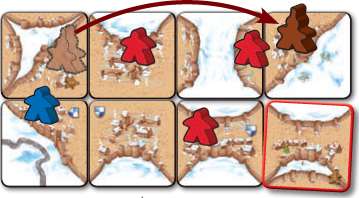
Red places a tile with the gingerbread man icon and moves the gingerbread man into the top right city.
Because the gingerbread man was removed from the left city, Blue scores 7 points (7 tiles, 1 knight) and Red 14 points (7 tiles, 2 knights).
Example for the 2nd type of scoring.
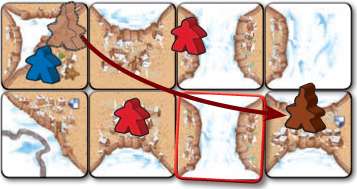
Red uses his tile to complete the city occupied by the gingerbread man. For the gingerbread man scoring, Blue scores 6 points (6 tiles, 1 knight) and Red 12 points (6 tiles, 2 knights).
Then Red scores 14 points for the city, as per the normal rules. Finally, Red moves the gingerbread man into an incomplete city.
Special Case
If there are no incomplete cities where the gingerbread man may move to, then he stays in the city he currently occupies.
If that city is completed, he is then removed from the board, and will be able to return to play when another gingerbread man tile is played.
Continue Reading


